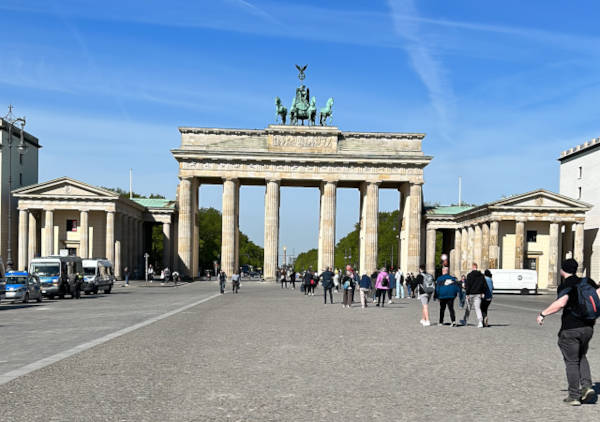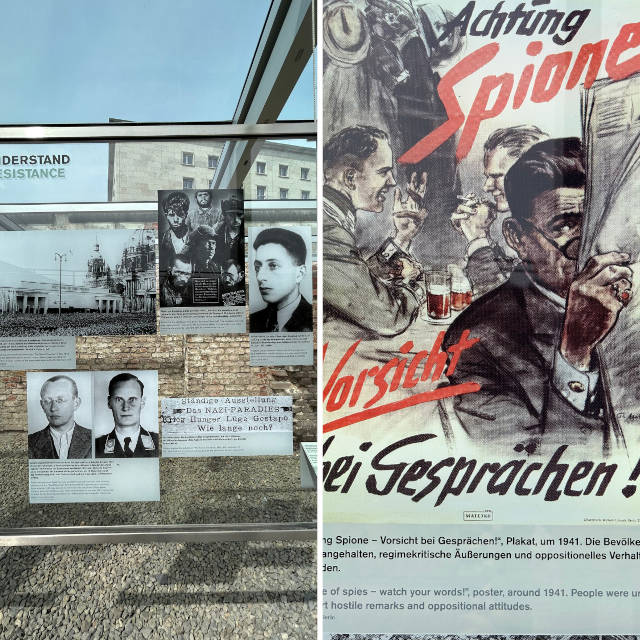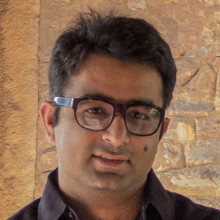[Clockwise from top left: The Holocaust Memorial; The Fraternal Kiss - perhaps the most famous mural of the East Side Gallery; at Mauerpark; graffiti on the Berlin Wall]
On May 4, 2023, just as I was about to set off on a World War II walking tour through the heart of Berlin, German authorities decided to defuse a 100-kg bomb dating back to that era, in the eastern part of the city. When us tourists heard the news, our first reactions were a mix of disbelief and amusement. We thought someone’s War-obsessed mind had cooked up an imaginary tale to justify the tour guide’s delayed arrival. But it was true. According to reports, the bomb was discovered two days earlier in the city’s Krautstrasse neighbourhood on a construction site.
For tourists like me, the discovery of an unexploded World War II-era bomb was unusual but for regular Berliners, this seemed to be a routine affair. After all, if there’s any city in Europe that reflected the ravages of that war, it was Berlin. And as someone who was always curious about World War II and the subsequent Cold War, it was only natural to make a trip to the German capital that is as contemporary as it is historic.
Walking into the past
Brandenburg Gate, our starting point, is an imposing 18th century structure built by the Prussian King Frederick William II. However, the French embassy that stands on the same square was rebuilt as recently as 2003. About a kilometre away stands the Reichstag, a 19th century building that once housed the Reichstag (lower house of parliament) of the German empire. It was redesigned during the 1990s so it could serve as reunified Germany’s new parliament. Atop the building sits a shiny glass dome with a walking track that provides visitors a panoramic view of Berlin, even as lawmakers are hard at work below. The symbolism is unmissable: the people are always above the powerful.

[Brandenburg Gate, the starting point of our walking tour]
Jim, our American tour guide, begins by telling us that if the Cold War was still on, all of us tourists and tour guides would’ve been dead. That’s because the area we stood on was the “death strip” in East Berlin, a no man’s land that stood between the Berlin Wall and West Berlin. In those dark days many East Berliners, trying to cross over to the other side, were killed by Soviet troops standing on watch towers that flanked the Brandenburg Gate. Under Nazi rule, the gate was a site for Hitler to demonstrate his military might. In 1940, German troops returning from the conquests of Poland and France marched through Brandenburg Gate. All the 18th century buildings around it were destroyed during the World War II air raids. Miraculously, only the Brandenburg Gate survived but its pillars are still riddled with bullet marks — a grim throwback to the dark days of 1945 when the Battle of Berlin damaged much of the city.
The two-hour-long walking tour covered other War-related landmarks such as the Tiergarten Memorial for the Soviet soldiers, Hitler’s underground bunker (now a nondescript parking lot) and the Detlev-Rohwedder-Haus, the only Nazi-era building to not have been destroyed after 1945. Once the Ministry of Aviation headed by the notorious Nazi politician Herman Goering, the inverted U-shaped structure, designed to make visitors feel small in its shadow, became part of East Germany after the War. The German Democratic Republic (GDR, as East Germany was known then) government realised that this building, constructed in just 18 months with over 2,000 rooms, would be ideal for administrative purposes. It first served as the office of the German Economic Commission in 1947 and later as the House of Ministries.

[The site of Hitler's underground bunker. It’s now a parking lot]
If Detlev-Rohwedder-Haus was designed to intimidate, our previous stop was made to trigger introspection. After reunification, one of the first acts of the German government was to publicly acknowledge the atrocities committed on the Jews under Nazi rule. It decided to build what is now the Memorial to the Murdered Jews of Europe (also known as the Holocaust Memorial), an open area filled with 2,711 unevenly-sized grey concrete slabs. Designed by Peter Eiseman, a New York-based architect, the memorial’s abstractness was deliberate, so visitors can derive their own meaning.

[The Memorial to the Murdered Jews of Europe, also known as the Holocaust Memorial]
To me, the grey slabs were symbolic of the Jews who, like other human beings, came in different shapes and sizes but shared a common race. As I walked through the narrow passages separating these slabs, I hoped that, like the German government, our government too publicly acknowledged its failures. One way to do so would be to build a memorial to remember the millions who lost their lives during the second wave of Covid-19, in 2021. Such a monument will serve as a reminder to India’s political class of the consequences of not investing in public health infrastructure and of not learning from the experiences of other countries. It might also help bring some closure to those who lost their loved ones.
Our next stop was the Topography of Terror, an indoor and outdoor museum about Nazi Germany. It is a pictorial retelling of how Adolf Hitler came to power and the ruthless manner in which he and his people targeted Jews and dissenters. The exhibition is mounted on a portion of the Berlin Wall that was never demolished. Walking past the wall filled me with a feeling of sadness and surrealism. The stuff that I had only read in books and watched in films had come to life (in a manner of speaking). I also couldn’t help but wish that those who yearn for Nazi-style rule in their countries pay a visit to this exhibition. Perhaps the detailed accounts of the horrors of that period might change their minds.

[Exhibits at the Topography of Terror]
Just as we were about to leave, Jim told us two remarkable facts that demonstrate Germany’s commitment to publicly acknowledge its dark past. First, the Topography of Terror Foundation building (the indoor museum) stands on the site where the headquarters of the Gestapo and the Sicherheitspolizei, the notorious secret police of the Nazis, once stood. Second, unlike other museums in Berlin which shut at 6 p.m., this is the only one that’s open till 8 p.m. because authorities want as many people as possible to see it.
From the World War to the Cold War
A day before I went on the Third Reich Walking Tour as it was called, I visited the East Side Gallery, where a 1.3-km-long stretch of the Berlin Wall now stands besides the Spree river. Located in Berlin’s Friedrichshain, over 100 artists were invited to draw murals on it soon after the Wall collapsed in 1989. The Gallery was officially opened in September 1990 and the art on it reflects the socialist values that united the Communist Bloc during the Cold War era. Perhaps the most famous mural of the Gallery is titled My God, Help Me To Survive This Deadly Love depicting the socialist fraternal kiss between Leonid Brezhnev, the Soviet President and Erich Honecker, his East German counterpart. First painted in 1990 by artist Dmitri Vrubel, it is one of Berlin’s most famous pieces of graffiti art reproducing this 1979 photo between the two leaders.

[The Fraternal Kiss]

[Socialist Bloc, the East Side Gallery]
It isn’t just the East Side Gallery that’s full of graffiti art. As I walked around East Berlin, I lost count of the number of residential buildings that had German words and phrases spray-painted on them, in blue, black, pink, red and green. I was curious to know the meaning of what was written but German pedestrians, with AirPods in their ears and a cold, mind-your-own-business demeanour didn’t seem like they were in the mood to entertain a tourist’s queries. A New York Times piece from 2008 called Berlin Europe’s “graffiti capital” and traced its roots to West Berlin in the 1980s. “But while the west face of the Berlin Wall was blanketed with graffiti, the east face was orderly and grey,” the piece said. “The notorious Stasi police kept graffiti under wraps, and writers in East Berlin risked imprisonment or worse if they were caught red-handed with spray cans — assuming they could even get their hands on paint.”
However, once the Berlin Wall fell in 1989, artists got many blank canvases in the East to express themselves. The rise of graffiti art also ran parallel to the influx of musicians, artists and counter culturalists, who wanted to make their own identity, towards East Berlin’s neighbourhoods. Today, some like Prenzlauer Berg are the trendiest and most expensive pieces of real estate in the city. A working class neighbourhood that was a refuge for dissidents and hippies during the Cold War, it now houses labels of independent designers and chic cafes.
Out of the shadows, a day in the sun

[Clockwise from left: People enjoying a sunny Sunday behind the flea market at Mauerpark, retro movie posters at a stall, vinyls for sale]
On my last day in the city, I returned to Prenzlauer Berg, to visit the weekly flea market at Mauerpark. It was a beautiful day filled with cliches of the European summer: the sun shining bright, a gentle breeze and puffy white clouds. Below the blue skies were stalls selling all manner of things: ceramics from Morocco, vinyl records, film posters, used lamps, caps, t-shirts and even lingerie to Berliners and tourists who were out in droves. The eclecticism extended to the food stalls as well, with Korean, Uruguayan, Argentinian and Middle-Eastern fare on offer, washed down with a 500 ml glass of chilled wheat beer. Outside the market area, at the Mauerpark amphitheatre, a group of dancers entertained a packed house. Nearby, families sat on the grass enjoying the spring sun and kids ran around with abandon. The joie-de-vivre was a reflection of Berlin’s new identity: a 21st century city, with a vibrant arts, culture and culinary scene that has made peace with its past.
My travel tips
- Berlin has an efficient and widespread public transport system and one is never too far away from an S-Bahn, U-Bahn, bus stop or a tram station. A six-day pass allows the holder unlimited travel in the city’s A,B, C zones on all of the above and costs Euro 56. The passes, known as the Berlin WelcomeCards, can be bought online, at the Brandenburg airport, the Berlin Central Station, hotels and at S-Bahn stops.
- Passes purchased offline need to be validated by inserting them into a machine that’s located on trams, trains, city railway stations and buses. Read the city’s official website for details.
- It is mandatory to pre-register before visiting the Reichstag dome — either online (advisable) or on-site (not advisable, due to the serpentine queues at the counters). I suggest purchasing skip-the-line guided tour tickets via private tour operators like Viator or GetMyGuide and avoid the hassle of standing in queues. Please carry a passport or a government-mandated identity card for security purposes.


